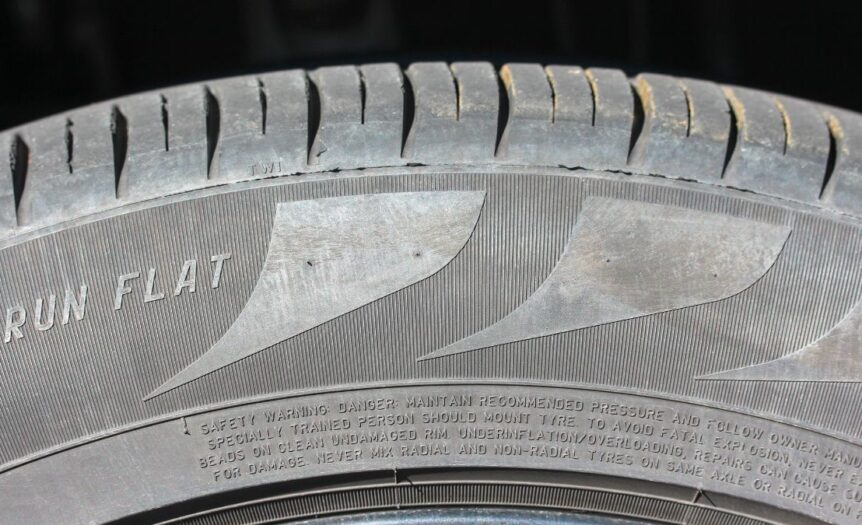One of the most impressive innovations in tire history is the run-flat tire. However, people still don’t know many things about this tire, despite it being more popular than ever. Below, we detail some facts about fun-flat tires you should know, from how useful they are to their construction and more.
There Are Two Types of Run-Flat Tires
While we typically think of run-flat tires as a uniform design, there’s more than one type. Run-flat tires are either self-supporting or contain a support ring.
Self-supporting run-flat tires feature a reinforced sidewall construction that can support the vehicle even when there’s a loss of air pressure in the tire. On the other hand, run-flat tires with support rings employ a ring of hard rubber (or another material) around the rim that can support the vehicle’s weight in the event of air loss. Self-sealing run-flat tires also exist, but they’re more advanced and expensive and less common than the other two.
Run-Flat Tires Can Operate for Miles With a Puncture
Another fact about run-flat tires you should know is they can travel many miles with little to no air pressure in the tire. This isn’t surprising given their name, but many drivers assume they’re useful for only a few miles. They’re much more capable than that.
The duration of a run-flat tire’s use without air pressure depends on the specific model type, vehicle weight, and speed. However, the standard bar for most is 50 miles at up to 50 miles per hour. While there are pros and cons of run-flat tires, they definitely offer a safety advantage. With that kind of durability and longevity, these tires give drivers enough time to find the nearest service center, tire shop, or safe place to change the tire themselves.
Roughly 1/6 of New Cars Come With Run-Flat Tires
While people consider run-flat tires unique and relatively rare in automotive circles, these tires are far more common. Approximately 15 percent, or roughly one out of every six new vehicles, comes with run-flat tires. They are especially popular with luxury automakers like Mercedes-Benz, Cadillac, and BMW because they’re more expensive than typical tires. Plus, they eliminate the need to include a spare.
Run-Flat Tires Save Weight and Space on Your Vehicle
As we mentioned, having run-flat tires offers indirect advantages to the vehicle and the driver, like not needing to keep a spare tire in the trunk or on the vehicle. While that may not seem a big deal, it significantly benefits the vehicle’s cargo space and fuel efficiency. Over the many miles of the vehicle’s lifespan, several fewer pounds translate to more than a few bucks saved in gas.





 Deering Estate
Deering Estate
 Massage Envy South Miami
Massage Envy South Miami
 Calla Blow Dry
Calla Blow Dry
 My Derma Clinic
My Derma Clinic
 Sushi Maki
Sushi Maki
 Sports Grill
Sports Grill
 The Healthy Kitchen
The Healthy Kitchen
 Golden Rule Seafood
Golden Rule Seafood
 Malanga Cuban Café
Malanga Cuban Café

 Kathleen Ballard
Kathleen Ballard
 Panter, Panter & Sampedro
Panter, Panter & Sampedro
 Vintage Liquors
Vintage Liquors
 The Dog from Ipanema
The Dog from Ipanema
 Rubinstein Family Chiropractic
Rubinstein Family Chiropractic
 Your Pet’s Best
Your Pet’s Best
 Indigo Republic
Indigo Republic




 ATR Luxury Homes
ATR Luxury Homes


 2112 Design Studio
2112 Design Studio
 Hamilton Fox & Company
Hamilton Fox & Company
 Creative Design Services
Creative Design Services
 Best Pest Professionals
Best Pest Professionals
 HD Tree Services
HD Tree Services
 Trinity Air Conditioning Company
Trinity Air Conditioning Company
 Cisca Construction & Development
Cisca Construction & Development
 Mosquito Joe
Mosquito Joe
 Cutler Bay Solar Solutions
Cutler Bay Solar Solutions


 Miami Royal Ballet & Dance
Miami Royal Ballet & Dance
 Christopher Columbus
Christopher Columbus
 Pineview Preschools
Pineview Preschools
 Westminster
Westminster
 Carrollton
Carrollton
 Lil’ Jungle
Lil’ Jungle
 Frost Science Museum
Frost Science Museum
 Palmer Trinity School
Palmer Trinity School
 South Florida Music
South Florida Music
 Pinecrest Orthodontics
Pinecrest Orthodontics
 Dr. Bob Pediatric Dentist
Dr. Bob Pediatric Dentist
 d.pediatrics
d.pediatrics
 South Miami Women’s Health
South Miami Women’s Health

 The Spot Barbershop
The Spot Barbershop
 My Derma Clinic
My Derma Clinic




 Miami Dance Project
Miami Dance Project

 Rubinstein Family Chiropractic
Rubinstein Family Chiropractic
 Indigo Republic
Indigo Republic

 Safes Universe
Safes Universe
 Vintage Liquors
Vintage Liquors
 Evenings Delight
Evenings Delight





 Atchana’s Homegrown Thai
Atchana’s Homegrown Thai
 Baptist Health South Florida
Baptist Health South Florida

 Laser Eye Center of Miami
Laser Eye Center of Miami
 Visiting Angels
Visiting Angels
 OpusCare of South Florida
OpusCare of South Florida

 Your Pet’s Best
Your Pet’s Best





 HD Tree Services
HD Tree Services
 Hamilton Fox & Company
Hamilton Fox & Company


 Creative Design Services
Creative Design Services